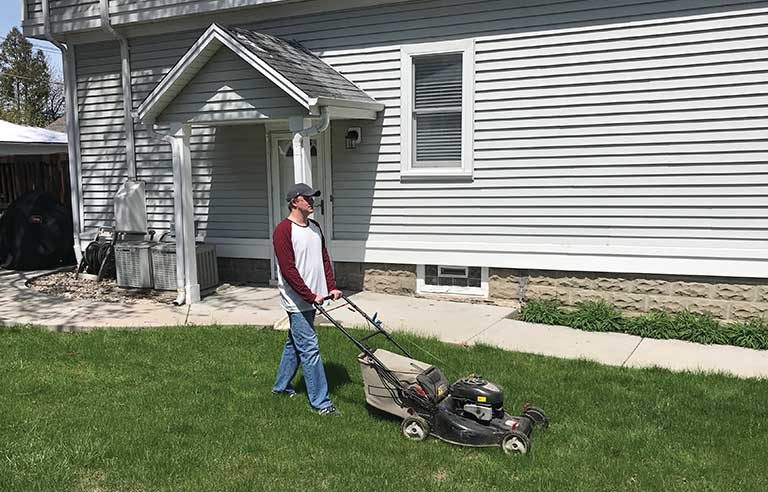Mow the lawn – without getting hurt
Follow these steps to avoid injuries

Sharp blades, objects hidden in tall grass, uneven terrain, inclement weather, hot engine parts – all of these are possible sources of injury when you’re mowing the lawn.
Nearly 6,400 lawn mower-related injuries were recorded annually from 2006 to 2013 in the United States, according to a 2018 study from the Johns Hopkins University School of Medicine.
So what can you do to stay safe?
Family Safety & Health spoke with experts to find out how homeowners can use lawn mowers without getting hurt and, here, presents five tips.
1. Watch for hazards
Rocks, sticks, toys and dog bones are just some of the objects that may be hidden by tall grass and weeds – and can turn into projectiles if run over by a mower.
Dr. Ben Hoffman, an associate professor of pediatrics at Doernbecher Children’s Hospital in Portland, OR, recommends you search your yard for hazards and remove them before mowing.
“Assume that there’s always a risk,” he said. “Assume there’s always going to be a rock that flies out at 100 mph.”
By sending younger children indoors, you can avoid another common hazard: kids approaching a mower in operation. As you mow, your focus may be on the ground and you may not notice a child until he or she is too close to the mower – and at risk.
2. Dress for success
Shorts and flip-flops may be the unofficial uniform of summer, but they’re inadequate for lawn-mowing duties. Protecting one’s eyes and feet are “absolutes,” Hoffman said. That means wearing closed-toed shoes and safety glasses when mowing.
“Eye injuries can be among the most devastating,” Hoffman said, “so I would say eye protection is mandatory.”
Wearing long pants and long-sleeved shirts can prevent injuries from hot mowers. And because mowers can be noisy, “you may want hearing protection as well,” said Elizabeth Klinefelter, a spokesperson for the Consumer Product Safety Commission.
3. Understand the effects of terrain, wet grass
Two of the most common challenges when mowing are slopes and wet grass. Klinefelter points out that both carry their fair share of danger.
“Slopes are a major factor related to loss of control and tip-over incidents (with riding mowers),” she said. “Operation on all slopes requires extra caution. If you cannot back up the slope, or if you feel uneasy on it, do not mow on it.”
When using a riding mower, go up and down slopes – never across – and keep your mower in gear when heading downhill, not coasting in neutral. “Avoid starting, stopping or turning on a slope,” Klinefelter added. Never use your foot for stability.
When using a walk-behind mower, go across the slope – never up and down, which could cause you to lose control and end up with a runaway mower.
Wet grass can limit traction and contribute to the loss of control of both kinds of mowers, Klinefelter said. It’s best to wait for your grass to dry before cutting it.
One more thing: Kids should never ride along on riding mowers. “They’re not built for passengers,” Hoffman said. “It may change the center of gravity and change the risk.”
4. Practice caution around mower parts
Knowing your way around a mower can help you avoid potentially devastating injuries. The engine, muffler and gas tank heat up to temperatures that can cause severe burns. Give the mower time to cool completely before you refuel it or make repairs.
If a discharge chute becomes clogged, “shut off the engine and wait for all parts to come to a complete stop before cleaning the machine, removing a grass catcher or unclogging the discharge,” Klinefelter said.
5. Know the right age
Children should be at least 12 years old before they operate a walk-behind or push mower, and 16 or older to drive a riding mower, the American Academy of Pediatrics says.
Hoffman, who is an AAP spokesperson, said parents also need to take into account their child’s behavior, physical strength, maturity and judgment before handing over mowing responsibilities.
“What I would ask parents to do is think about all the skills that would be required to safely utilize the equipment,” Hoffman said. “Then, you have to trust the child is competent and trust they can do it. It’s knowing the child is capable of doing it and trusting them to handle it independently. “The more we can do to minimize the risk, the better.”
Post a comment to this article
Safety+Health welcomes comments that promote respectful dialogue. Please stay on topic. Comments that contain personal attacks, profanity or abusive language – or those aggressively promoting products or services – will be removed. We reserve the right to determine which comments violate our comment policy. (Anonymous comments are welcome; merely skip the “name” field in the comment box. An email address is required but will not be included with your comment.)
